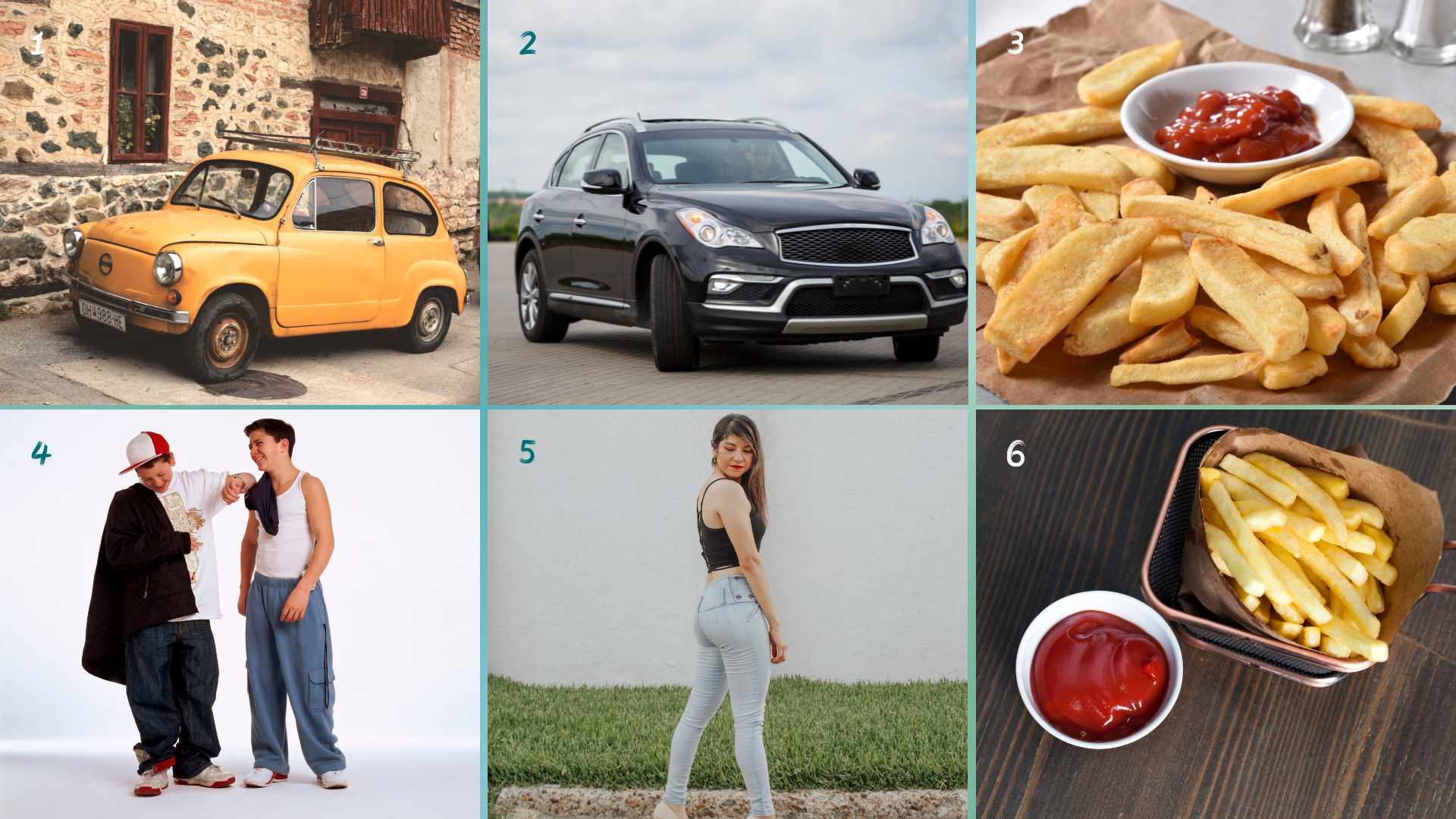Explore basic Polish vocabulary about shapes like kwadrat (square), okrągły (round), and trójkąt (triangle), and learn to describe everyday objects by their form, such as stolik (small table) and obraz (picture). This lesson helps you confidently discuss shapes and forms in practical contexts.
Exercises Share Copied!
These exercises can be done together during conversation lessons or as homework.
Exercise 1: Reorder sentences
Instruction: Make correct sentences and translate.
Exercise 2: Match a word
Instruction: Match the translations
Exercise 3: Cluster the words
Instruction: Assign the following words to one of two categories: 'Geometric shapes' or 'Everyday object forms'.
Kształty geometryczne
Formy codziennych przedmiotów
Ćwiczenie 4: Conversation exercise
Instrukcja:
- Opisz obrazki i porównaj je. (Describe the pictures and compare them. )
- Zapytaj innych, co wolą. Mniejsze czy większe samochody, .... ? (Ask the others what they prefer. Smaller or bigger cars, .... ?)
Teaching guidelines +/- 10 minutes
Example phrases:
|
Ten samochód jest mały i stary. This car is small and old. |
|
Ten samochód jest większy i nowszy. That car is bigger and newer. |
|
Chłopcy noszą szersze spodnie. The boys are wearing wider trousers. |
|
Jaki samochód preferujesz? What car do you prefer? |
|
Wolę mniejsze, ale bardziej nowoczesne auto. I prefer a smaller but more modern car. |
|
Wolę stare samochody. I prefer old cars. |
|
Ulica jest bardzo wąska. The street is very narrow. |
| ... |
Exercise 5: Dialogue Cards
Instruction: Select a situation and practice the conversation with your teacher or fellow students.
Exercise 6: Multiple Choice
Instruction: Choose the correct solution
1. Lubię, gdy stół ___ kwadratowy.
(I like it when the table ___ square.)2. Obraz na ścianie ___ piękny, okrągły kształt.
(The picture on the wall ___ a beautiful, round shape.)3. Moja przyjaciółka ___ proste linie na kartce.
(My friend ___ straight lines on the paper.)4. W pracy często ___ kształty i kolory przedmiotów.
(At work I often ___ shapes and colors of objects.)Exercise 7: Choosing Furniture for a New Apartment
Instruction:
Verb Tables
Iść - To go
Czas teraźniejszy
- ja idę
- ty idziesz
- on/ona/ono idzie
- my idziemy
- wy idziecie
- oni/one idą
Chcieć - To want
Czas teraźniejszy
- ja chcę
- ty chcesz
- on/ona/ono chce
- my chcemy
- wy chcecie
- oni/one chcą
Lubić - To like
Czas teraźniejszy
- ja lubię
- ty lubisz
- on/ona/ono lubi
- my lubimy
- wy lubicie
- oni/one lubią
Pokazywać - To show
Czas teraźniejszy
- ja pokazuję
- ty pokazujesz
- on/ona/ono pokazuje
- my pokazujemy
- wy pokazujecie
- oni/one pokazują
Wybierać - To choose
Czas teraźniejszy
- ja wybieram
- ty wybierasz
- on/ona/ono wybiera
- my wybieramy
- wy wybieracie
- oni/one wybierają
Pasować - To fit
Czas teraźniejszy
- ja pasuję
- ty pasujesz
- on/ona/ono pasuje
- my pasujemy
- wy pasujecie
- oni/one pasują
Don't see progress when learning on your own? Study this material with a certified teacher!
Do you want to practice Polish today? That is possible! Just contact one of our teachers today.
Lesson Overview: Shapes and Forms in Polish
This lesson introduces fundamental vocabulary and everyday expressions related to shapes and forms, focusing on common geometric shapes and the forms of familiar objects. It is designed for A1 learners and covers basic description skills and essential verbs used to describe appearance and preferences.
Key Vocabulary: Geometric Shapes and Everyday Forms
You will learn important nouns to describe shapes such as koło (circle), kwadrat (square), trójkąt (triangle), prostokąt (rectangle), and gwiazda (star). These are often used to describe both abstract shapes and physical everyday items.
Additionally, everyday object forms like kubek (mug), książka (book), telefon (phone), and krzesło (chair) help you connect shapes with real-life items.
Using Descriptive Sentences
Example sentences demonstrate how to describe objects using shape adjectives: "Ten kwiat ma okrągły kształt." (This flower has a round shape.) or "Moje okno jest duże i kwadratowe." (My window is large and square.) These examples show the adjective endings agree with the nouns in gender and number.
Simple Dialogues: Expressing Preferences
The lesson includes dialogues in typical scenarios such as shopping for decorations or discussing art, where you practice expressing opinions and preferences about shapes, e.g., "Czy podoba ci się ta okrągła lampa?" (Do you like this round lamp?) and responding with sentences like "Wolę okręgi, więc wybiorę lampę." (I prefer circles, so I will choose the lamp.)
Verb Practice: Describing and Choosing
Important verbs like lubić (to like), mieć (to have), opisywać (to describe), and others are presented in multiple choice exercises and a mini story about buying furniture. These reinforce the correct use of present tense conjugations in relevant contexts.
Useful Language Notes
Unlike English, Polish adjectives describing shapes change their endings to match the gender, number, and case of the noun they modify. For example, "okrągły stół" (round table – masculine), but "okrągła lampa" (round lamp – feminine). Learners should pay attention to these agreements as they are essential for natural speech.
Expressions like "Jaki kształt ma ten stół?" (What shape is this table?) can help you ask questions about shapes. Similarly, the phrase "Lubię..." (I like...) is a fundamental way to express preferences.
Summary
- Learn geometric shapes and how they describe objects.
- Practice forming descriptive sentences with correct adjective-noun agreement.
- Engage with dialogues to express likes and dislikes about shapes.
- Study useful verbs with present tense conjugation to describe and choose objects.
- Understand the difference in adjective use compared to English.








